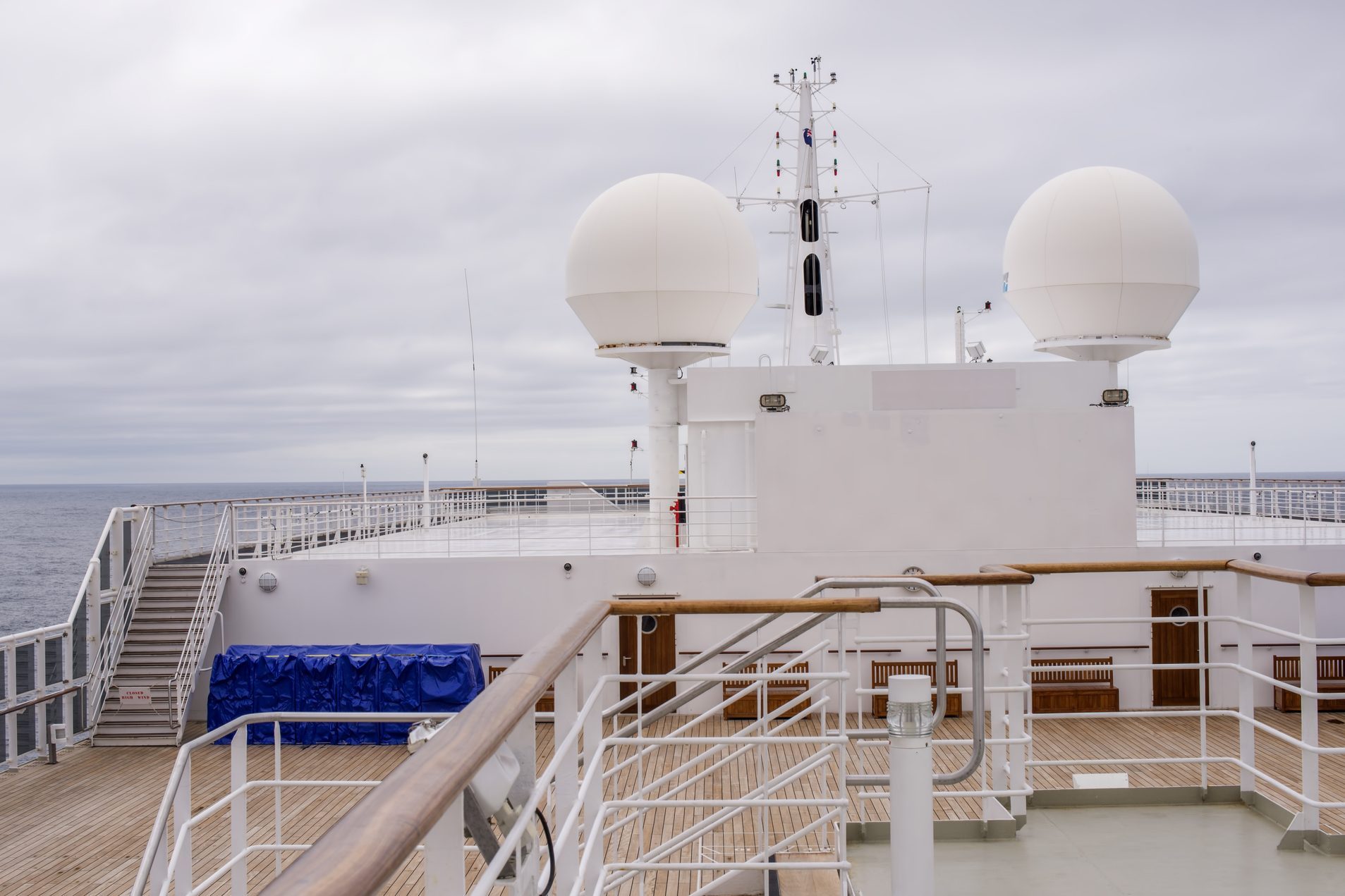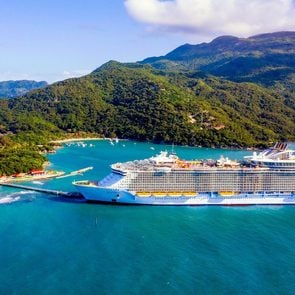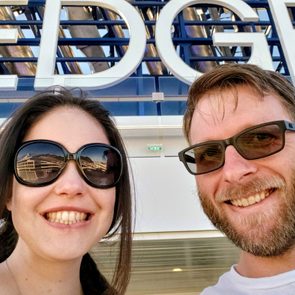What are the big balls on cruise ships? It's time to dock into the port of information and add some cargo to your cruise ship knowledge.

This Is What Those Big White Balls on Top of Cruise Ships Are

Whether you’re a seasoned cruiser or a newbie on the high seas, the thrill of boarding a cruise ship at the beginning of your voyage never goes away. Sure, the ocean is huge, but your new floating home is big enough to take on the seven seas. Standing on the dock, you’ll look up—and up and up—to decks filled with food and fun. Massive ocean liners are triumphs of engineering crowned with … wait, what are the big balls on cruise ships?
There may be secret cruise ship code words and hidden features on cruise ships, but those big white balls aren’t flying under the radar. If white domes top your ship, you’ll know it. And you’ll probably wonder what they’re there for. Do they only appear on the best cruise lines, or are they related to one of the things you won’t be able to do on cruises anymore?
Chances are, you’re on this voyage to relax, soak up the sun and see some of nature’s wonders—not to solve mysteries (unless your themed cruise offers a murder-mystery dinner party, of course!). To save you from pondering the riddles of your vessel in the buffet line, we’ve hunted down experts to answer the burning question: What are the big balls on cruise ships? The answer may surprise you! Turns out, they have several essential functions.
Get Reader’s Digest’s Read Up newsletter for more travel, humor, cleaning, tech and fun facts all week long.
What are the big balls on cruise ships?
The big white balls on cruise ships are known as radomes. The name is “a portmanteau of the words ‘radar’ and ‘dome,'” says Beau Ragland, CEO of unique travel experience company Voyista Travel. According to Ragland, the protective dome shields the sensitive radar antenna from the elements and the corroding effects of saltwater.
Radomes’ position on the unobstructed top of the ship makes it easier for the equipment to work properly. Anyone who’s been on a boat—be that a fishing vessel, Disney cruise, singles cruise or any other ship—knows that the open sea can be a challenging environment. Radomes spend most of their time battling high winds, storms, salt spray, sunlight and seabirds. As such, they’re made of high-performance materials, allowing them to function properly despite harsh seafaring conditions.
What are radomes used for?
According to Elaine Warren, founder and CEO of The Family Cruise Companion, a travel blog that specializes in (no surprise here) family cruises, radomes allow cruise ships to stay in touch with shore-side systems and other ships via radar. “They even help the ship move more efficiently by reducing wind resistance,” she says.
Ragland adds that radomes detect other ships, land masses and navigational hazards. “This is crucial for the safety and navigation of the ship and helps the crew to make informed decisions about route planning and avoiding potential hazards,” he says.
If you’ve ever browsed the internet while on an all-inclusive cruise or done some online shopping in your cabin, you’ve got radomes to thank. They provide satellite coverage, offering internet and phone service for cruise customers. And, says Ragland, they provide real-time weather monitoring, a vital feature that allows the crew to navigate around storms.
They may look funny, but radomes are essential. And when the answer to “what are the big balls on cruise ships?” isn’t just an interesting fact but “the thing that keeps you safe and lets you hunt online for the best restaurant at your next port of call,” who cares what they look like?
Why are radomes white?
No matter the cruise ship you board, the radomes will most likely be white, and there are a couple good reasons for that. For starters, white reflects sunlight, keeping the radar equipment inside the radome cool and allowing it to operate properly. Beyond that, white blends in well with the rest of the ship, which tends to be white or light-colored. After a few days at sea, you probably won’t even notice them.
Do all cruise ships have radomes?
As Warren explains, not all cruise ships have radomes. “It really depends on the ship’s size and level of technology,” she says. “For example, the bigger and more advanced ships might have radomes, but the smaller ships probably won’t.”
Ragland agrees. “Some smaller ships may not require radar coverage or have other navigational equipment,” he says. “However, most larger ships and commercial vessels will have radomes, as they are an important safety feature.”
While you’re at it, also learn why cruise ships have wings.
Where else can you see radomes?
Now that you know what the big balls on cruise ships are, you’ll notice radomes in tons of places. Warren has seen them on ships, aircraft, satellites and telecommunications towers. “I’ve even seen them at military bases, airports and other secure locations,” she says.
Here’s some great airplane trivia: A plane’s radome is usually hidden in its cone-shaped nose. In fact, radomes enable us to text and email from 30,000 feet in the air. “The little ‘bump’ you see atop newer commercial aircraft usually is a radome that encloses the flight’s satellite internet antenna and enables in-flight Wi-Fi,” Ragland explains.
In short, radomes might appear in any place where antennas need to be protected from the weather. Now that you know what the big balls on cruise ships are, it’s time to book your next cruise! Find out if cruises have recovered from the pandemic, then get ready with our comprehensive cruise packing list.
Sources:
- Beau Ragland, CEO of Voyista Travel
- Elaine Warren, founder and CEO of The Family Cruise Companion
- Aviation Technical Services: “Radomes”





















